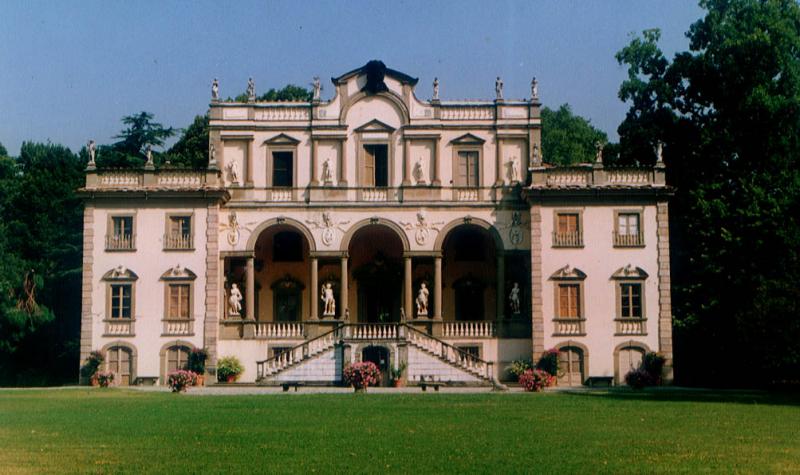
Villa Mansi
This post is also available in:
 Italiano (Italian)
Italiano (Italian)
Villa Mansi, in Segromigno in Monte, is one of the greatest expressions of XVII century architecture in Lucca. Already before the XVI century, the Mansi was a family known at European level in the field of the silk trade and had close relations with several patrician families of Lucca: thanks to them, they were able to purchase Villa di Segromigno in the XVII century.
THE VILLA
The original building from the mid-XVIcentury looks like a sturdy structure with a lively façade: that’s because the central body, which is higher, is slightly set back from the two side structures. The porch of the mezzanine floor, the double flight of stairs, the chromatic contrast between the plaster and the architectural and decorative elements, also contribute to adding “movement” to the building. Under the Mansi family, the complex underwent a renovation of the facade by the architect Giusti from Lucca: he decorated it with the balustrade at the top and with several statues on the roof. In the same period, several other features were added by the architect Filippo Juvarra, such as the lock works, the hydraulic arrangement and the tripartition of the garden.
Among several Baroque frescoes inside the villa, those in the central hall are surely the most interesting: they were created by the neoclassical painter Stefano Tofanelli, particularly appreciated by Elisa Baciocchi, Napoleon Bonaparte’s sister.
THE GARDEN
The first arrangement of the park dates back to the XVIII century, according to the French-styled project by the architect Filippo Juvara. He eliminated the classic Italian geometric garden and terraces in favour of a slope, and also created a water system that allowed water games: today, only a large symmetrical pool remains.
Such initial arrangement was dramatically modified in the early XIX century when the garden was turned into a much more romantic facility like the adjacent natural park. In the second half of the XX century, further changes were introduced with the addition of plaster putti and a parterre.
Of the original plant species dating back to the XVII-century, some specimens of oaks and yews can still be seen, as well as some stretches of laurel and box hedges, not to mention a beautiful camellia (Camelia japonica) on the west side of the garden.
In the botanical garden, there are more than 40 tree species, including examples of tulip trees (Liriodendron tulipifera), paper mulberry (Brussonetia papyfera), California cedar (Calocedrus Decurrens “Aureovariegata”), and Carya ovata.
This post is also available in:
 Italiano (Italian)
Italiano (Italian)
Contatti
Via delle Selvette 242 - Capannori(LU)
0583 920234
info@villamansi.it
Altre info
dal 1° aprile al 31 ottobre dalle 10.00 alle 13.00 e dalle 15.00 alle 18.00; dal 1° novembre al 31 marzo dalle 10.00 alle 13.00 e dalle 15.00 alle 17.00; Giorno di chiusura settimanale lunedì


